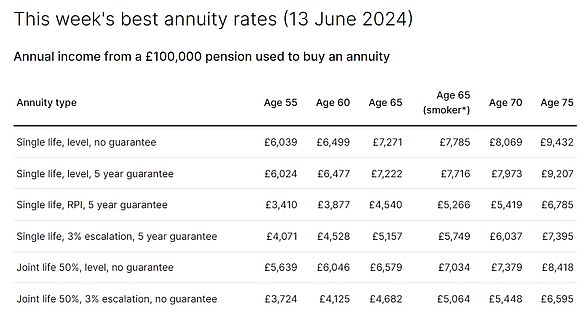How much extra does an inflation-linked annuity cost and is it beneficial?
Retirement Income: Annuities offer a guaranteed income until you die, and the deals have improved thanks to higher interest rates
The value of annuities has increased dramatically in recent years, but the best rates apply to annuities for one person, without inflation adjustment.
According to data from Best Buy (see below), a healthy 65-year-old can secure an income of over £7,270 a year for £100,000.
You can deduct £2,000 a year or even more of that if you want an annuity that increases by 3 per cent a year or in line with Retail Price Index inflation.
An annuity may seem attractive now that inflation is back at 2 percent, but recent history has shown how dangerous it is to lock in an income for life without protection against a sudden rise in the cost of living.
The inflation rate reached over 11 percent in October 2022, the highest level in 41 years.
If you are looking for an annuity, how do you calculate whether an annuity with or without inflation resistance is the best option for you? Money experts crunch the numbers and give you tips on how to make the choice below.
Making an annuity inflation-proof: How much extra does it cost?
A 65-year-old with a pension pot of £100,000 could now get up to £7,220 a year from a lump sum annuity with a five-year guarantee, says Helen Morrissey, head of pensions analysis at Hargreaves Lansdown.
A warranty period protects you against the loss of the entire purchase price or a large part of it if you die shortly afterwards.
The top rate is more than £2,000 higher a year than you would have received three years ago, Morrissey said.
But she warns: ‘The amount of income you receive from such an annuity does not change over time. What seems like a healthy income today could be very modest in 20 years.
‘An RPI-linked annuity currently yields a maximum of £4,540 per year for 65-year-olds with a pension of £100,000.
‘A loan rising at 3 per cent a year will cost you from £5,157.’ Both rates include a five-year guarantee.
Morrissey says the latter two deals can be much lower than what you would get with a level annuity, but the longer you live, the more you will value any kind of inflation link. This is illustrated in the table below.

Source: Annuity figures from Hargreaves Lansdown
“When determining the best option, try to calculate how long it will take for the income from your increasing annuities to equal the starting income of Level 1,” Morrissey said.
‘If you choose the RPI product and interest rates rise by 5 percent per year, it will take 10 years to catch up and about 20 years before you are generating the same income as with the flat product.
‘Of course you would recover ground faster if RPI inflation was higher, but with lower inflation it could take longer.’
She says it would take 12 years to get back to the same level as the annuity, which is now 3 percent per year. You would be 77 years old before you had the same income again.
And it would take about 21 years before you had the same total income of about £144,000 as with the flat product.

Helen Morrissey: The longer you live, the more you value any form of inflation linkage
Morrissey says, “You need to think carefully about how long you’re likely to live so you can make the best decision for you.”
Unless you have an existing health condition, or unless you think this condition may run in your family, the answer to this question is unknown.
But if you look at the numbers, you will at least get a better picture of the risks you run if you buy an annuity with or without inflation resistance.
Morrissey warns: ‘The inflation monster may have been tamed, but that doesn’t mean it shouldn’t be an important factor in planning your retirement income.
‘You can be retired for 20 years or more and even the most favorable inflationary conditions can erode your purchasing power over that time.
‘A period of double-digit inflation, as we have seen recently, can take a big bite out of your plans, so it pays to be prepared.’
She says you can also consider other options, such as not converting your entire pension into an annuity at once.
Instead, you can divide your money into installments, ensuring you have a guaranteed income when you need it, while investing the rest so it can hopefully grow.
‘This way, you also benefit from higher annuity rates as you get older. And if you develop a condition that makes you eligible for an increased annuity, you can increase your income even further, which can help you counter the effects of inflation over time.’
Fixed Rate vs. Inflation-Linked Annuities: How to Decide

Nick Flynn: Understand how the annuity provider defines and measures inflation, and consider your overall tax position
Nick Flynn, director of retirement income at Canada Life, offers the following tips.
1. Think about how your annuity income may change in the future
With inflation-linked annuities, the starting income is usually lower than with fixed-rate annuities. However, this can change over time.
By making some simple assumptions about the future direction of inflation, you can map out how your inflation-linked annuity will rise in the future, at what age your income will catch up to the fixed annuity premium, and at what age you are likely to receive more income than you originally paid for it.
2. Check how the provider applies inflation to the annuity rate
If you are considering an inflation-linked annuity, it is important to understand how the provider defines and measures inflation and how they pass on changes to your income.
3. Consider your tax position
Make sure you consider your overall tax position and identify any tax implications of your annuity and any other income you receive.
An inflation-linked annuity that increases over time may be a solution for some people that suits their current tax position, while others may prefer the higher starting income that a fixed rate annuity brings.
4. Consider a mixed approach
Unless you have a very small pension pot, there are usually several options available to you.
It may be that a mixed approach – for example a mix of fixed and inflation-linked annuities, or adding an element of drawdown – gives you the best chance of meeting your retirement goals.
5. Do your research and speak to a licensed financial advisor
Compare prices from multiple providers and do some preliminary research to better understand your options.
Then contact a certified financial advisor. He or she can help you make the decision that best suits your situation and needs.
Some links in this article may be affiliate links. If you click on them, we may earn a small commission. That helps us fund This Is Money and keep it free. We do not write articles to promote products. We do not allow commercial relationships to influence our editorial independence.


